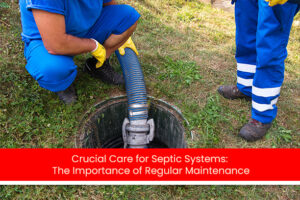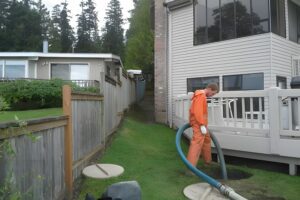One of the best things a residential or commercial septic tank owner can do is invest in routine inspection, diagnosis, repair, and maintenance. Professional upkeep ensures the tank’s optimal health and functionality for many years.
Many properties require a designated septic system for their wastewater outflow, but as is easy to imagine, sewage accumulation can eventually diminish a septic tank’s working capacity. One of the only ways to avoid the issues associated with drain water accumulation is to invest in routine inspection, maintenance, diagnosis, and repair by experienced plumbing specialists.
In this blog post, we’ll address the importance of septic system maintenance and outline key strategies for effective upkeep.
Signs of Septic System Problems
Some common signs of septic tank distress include,
- Strange, gurgling sounds in the plumbing system.
- Bathtubs, sinks, and showers drain very slowly.
- Standing/pooling water or damp spots near the drain field or the septic area.
- Algal blooms in nearby ponds or lakes.
- Bright green, lush, spongy grass over the drainfield or septic tank, even during dry weather.
- Foul odors around the leach field or septic tank.
- Wastewater and sewage from toilets, drains, and sinks back up into the property.
- High levels of nitrates or coliform bacteria in water wells.
Importance of Regular Septic Maintenance
Routine septic tank maintenance is essential to the integrity of your residential or commercial property, the health of people, and the environment. Even though your property size and the total number of household members certainly play a role, septic tanks should be maintained every six months on average. Upholding a regular septic inspection, maintenance, diagnosis, and repair schedule can preserve the longevity of your septic tank and prevent dangerous property damage and septic contamination.
Best Practices for Septic System Maintenance
1. Inspect and Pump Frequently
Most solids that enter the septic system decompose over time. However, there are always exceptions, and these materials can gradually build up inside the septic tank to the point of expensive damage. That’s why it’s essential to schedule routine septic inspections and pumping before any issues arise.
According to the EPA, it’s advisable to schedule professional septic tank flushing every five years, with a potential need for more frequent maintenance, possibly every two years. The exact timing depends on the size of your tank and your household’s demands.
The major factors that influence how often to pump your septic system include:
- Household size
- Total wastewater generated
- The volume of solids in wastewater
- Septic tank size
2. Recognize the signs
Some warning signals of septic tank system distress are easy to spot. If you notice slow-draining drains, sinks, and toilets, bad odors, or wastewater backing up in the property, contact a professional septic tank diagnosis and repair service like A Wesco Septic, Inc. to assess the health of your septic system.
3. Use water efficiently
Excessive water in the septic system can affect the performance of beneficial microorganisms and disturb its natural balance. It can also stress the system and cause it to flood or fail. This is why local septic tank service providers like A Wesco Septic, Inc. recommend using water efficiently to reduce the amount of water entering the system.
You can take robust measures, such as repairing leaking faucets, using flush-free toilets, or using high-efficiency shower heads that reduce water use.
4. Waste disposal
What goes down the drain directly affects the operation of your septic tank. Therefore, don’t use toilets as trash cans. Besides toilet paper and human waste, never flush other items. According to the top septic tank service provider in Snohomish, A Wesco Septic, Inc., some common items people shouldn’t flush down the toilet include,
- Fats, Oils, and Grease
- Non-flushable wipes/Baby wipes/Wet wipes
- Female Hygiene Products
- Medicines
- Gasoline
- Pesticides
- Paint or paint thinners
- Photographic solutions
- Coffee grounds
- Paper towels
These items can kill microorganisms in the septic system, surrounding soil, and groundwater.
5. Be Aware of the Drainfield
An essential part of any septic unit is the drain field (or leach field), where wastewater is released after being filtered through the system. Leading septic system repair contractors from qualified companies like A Wesco Septic, Inc. reveal that if you’re moving into a property with an existing septic system, you should properly understand the drainfield boundaries.
Furthermore, avoid planting anything other than grass over the drainfield, as bigger root systems can lead to blockages, clogs, or damage. It’s important to avoid driving or parking vehicles and constructing anything over the septic field to preserve its integrity and structure.
Final Takeaway
Septic tank maintenance is crucial to the safety of your commercial or residential property. Scheduling maintenance every six months prevents potential damage and contamination. For further inspection, diagnosis, repair, and maintenance information, feel free to contact the professionals at A Wesco Septic, Inc. We’re a full-service sewage and septic specialist in Snohomish, Arlington, Lake Stevens, Mill Creek, Lynnwood, WA, and nearby areas.
Whether you need your septic tank pumped, your existing septic system repaired, or a real estate inspection performed, A Wesco Septic, Inc. is here to assist you every step of the way. Our team of experts ensures that your septic system remains in optimal condition, safeguarding your property and the environment. You can rely completely on us to deliver expert solutions tailored to your specific needs.
Contact us at (360) 668-6561 to schedule an appointment with our team today.




